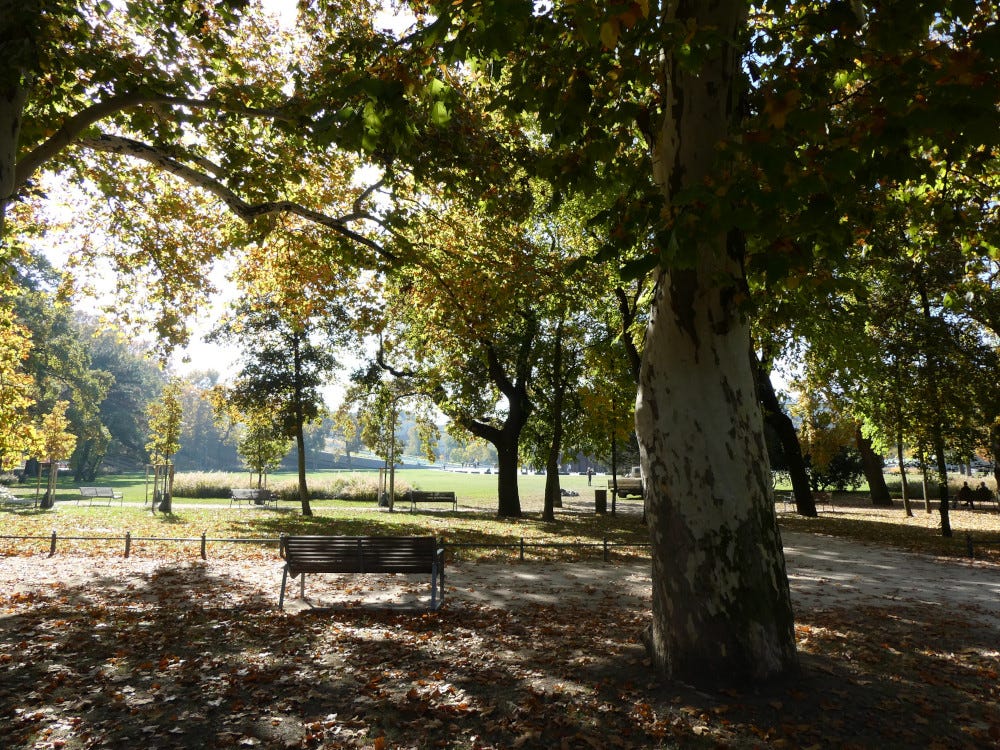There’s a lot going on in the centre of Budapest and along the banks of the Danube but perhaps you haven’t realised there’s also a lot going on in a much greener quieter part of the city, the huge Városliget, Budapest’s City Park.
Start by taking metro line 1 northbound to Hősök tere, Heroes Square. There are other ways to get there but since we’re enjoying the park today, we might as well get acquainted with the metro line that directly joins the city centre to the park and runs the entire length of Andássy út, Budapest’s flagship boulevard. Line 1 is the second oldest underground railway in the world after the London Underground – specifically the Metropolitan line – which makes it the oldest in mainland Europe, the oldest in Hungary and the oldest in any category you can plausibly exclude London from. It was opened in 1896 with small trains powered by overhead electrical lines, in contrast to London which used small steam locomotives- if you think the atmosphere on the Tube is grim today, imagine the smoke in there during the 1800s! Unlike the other lines in Budapest, which use open-plan modern shiny metro trains, line 1 uses an unusual little yellow train formed of three small cars with a cute “face” at the front with two headlights pressed together in the middle, making it look a lot more like an overgrown toy than the celebrated ancient public transport network of a major city. Wikipedia says it takes eleven minutes to run the entire length of the line but it never occurred to me to time it.
Hop off at Hősök tere. You can carry on to Széchenyi fürdő, the station right outside the famous yellow baths, but I think if you’re going to explore the park properly, you should start at Heroes Square. This square is home to the Millennium Monument – not a celebration of the year 2000 but of the 1000th anniversary of the Hungarian conquest of the Carpathian Basin. It’s two huge curved colonnades with statues of various Hungarian kings and chieftains standing between the columns and in the middle is a column topped with the angel Gabriel, except when I was there, the entire thing was covered in “a comical amount of scaffolding” because Gabriel was being removed to be renovated. It was also the week of Halloween and there were carved pumpkins laid all around the Millennium Monument, which was just about the last place I would have expected to find Halloween decorations.
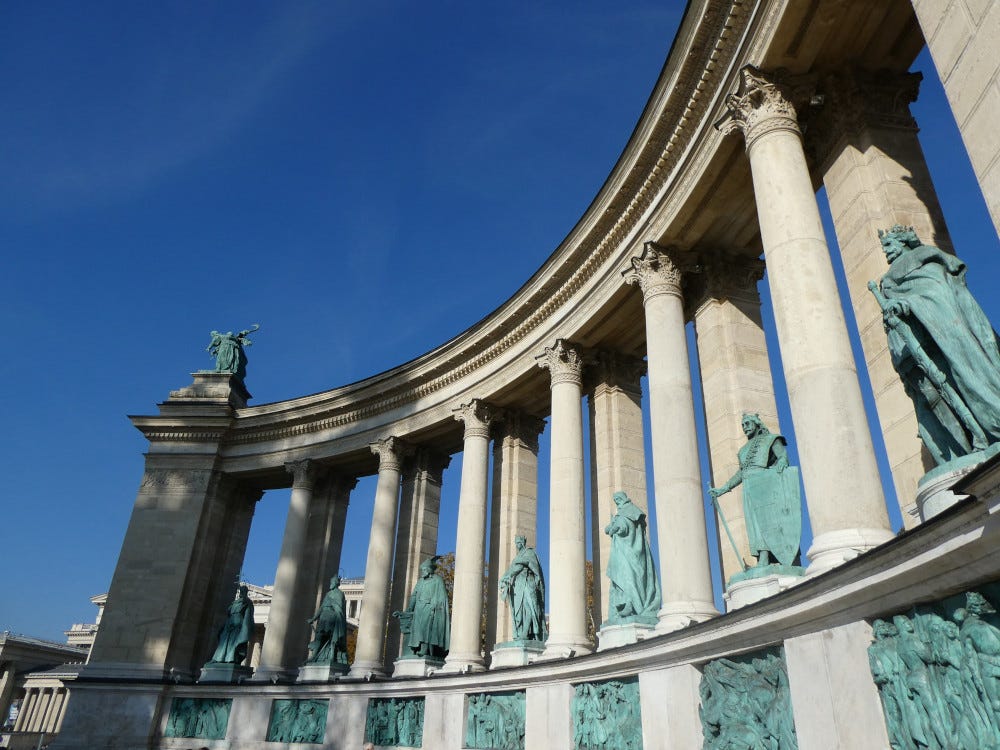
Finally, somewhat overshadowed by the monument and column, is the Memorial Stone of Heroes, the Hungarian national cenotaph. Unusually and despite what guidebooks often say, there’s no Tomb of the Unknown Soldier here. Behind it is an artesian well – which means a well that brings water up borehole using its own natural pressure change rather than a pump. This well feeds Széchenyi Baths, which I hadn’t realised. I knew there was a well but I assumed it was closer to the baths and not in the middle of a national monument!
I’m not an art gallery or museum sort of person so I skipped over them but to the right of Heroes Square is the Hall of Art, housed in a Neo-classical Greek Revival building with triangular pediment and columns, and to the left is the Museum of Fine Arts, in a similar building. If that’s your thing, you could probably spent an entire day just here in this square. But let’s move into the park. The first part is dominated by a large boating lake, or at least it is in summer. When I was there in late October, it was empty, except a few contractors’ vehicles and apparently being converted into a skating rink for the winter. I think I need to go back to Budapest when it’s cold and snowy and enjoy that sort of thing, as well as get my hair frozen off in the outdoor baths. It’s overlooked by a castle, which looks fairly medieval but was in fact built in the 1890s and is inspired by Corvin Castle in Romania. If you want to go in and see what it’s like inside rather than merely as a pretty backdrop to the park, it contains the Museum of Hungarian Agriculture, which again, didn’t appeal to me personally but it had a huge queue outside. It also does tours up to the roof if you want to see the park from above.
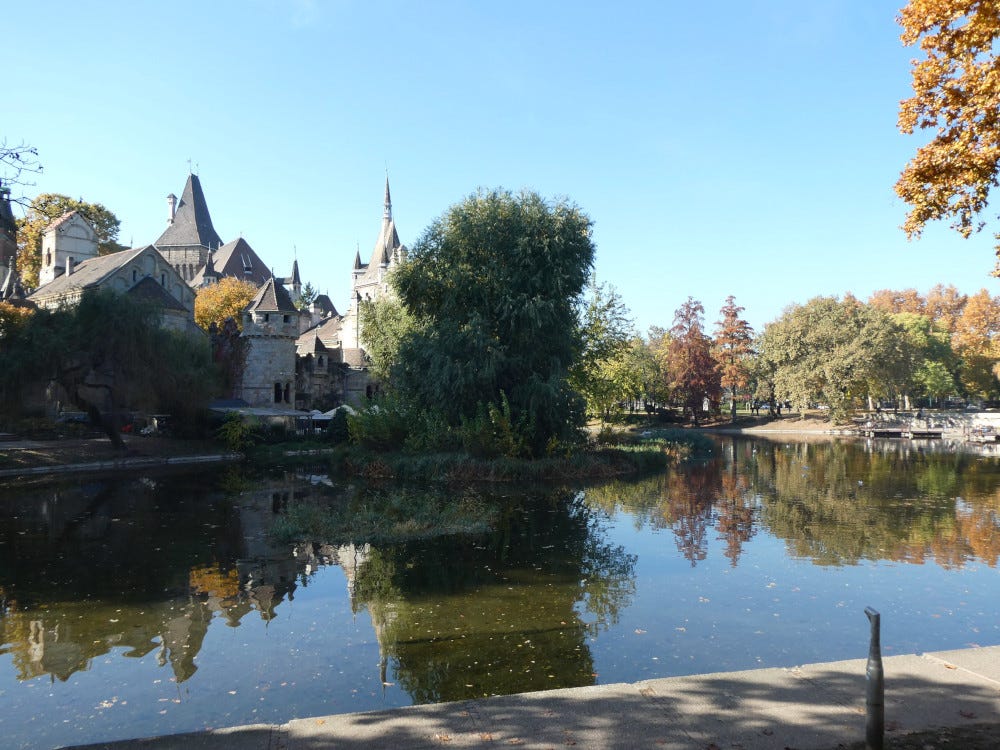
But if you want to see the park from right above, there’s an even more fun option – BalloonFly! It’s a tethered helium balloon which is winched up on a cable to 150m, giving you views of the park, the city, across to Buda and the mountains. It does get busy, so I didn’t originally intend to go up but when I went to investigate, there was no queue. Your ticket has a number and it gives you an idea of how long you have to wait before your turn, although in my case, it wasn’t 30 minutes, it was barely 15. It means that if you’ve got ages, you can wander off and come back later or if you’ve only got a little while, you can sit in the cafe right next to it. When I bought my ticket, the balloon was just loading and just about to go up but I was on the very next “flight”.
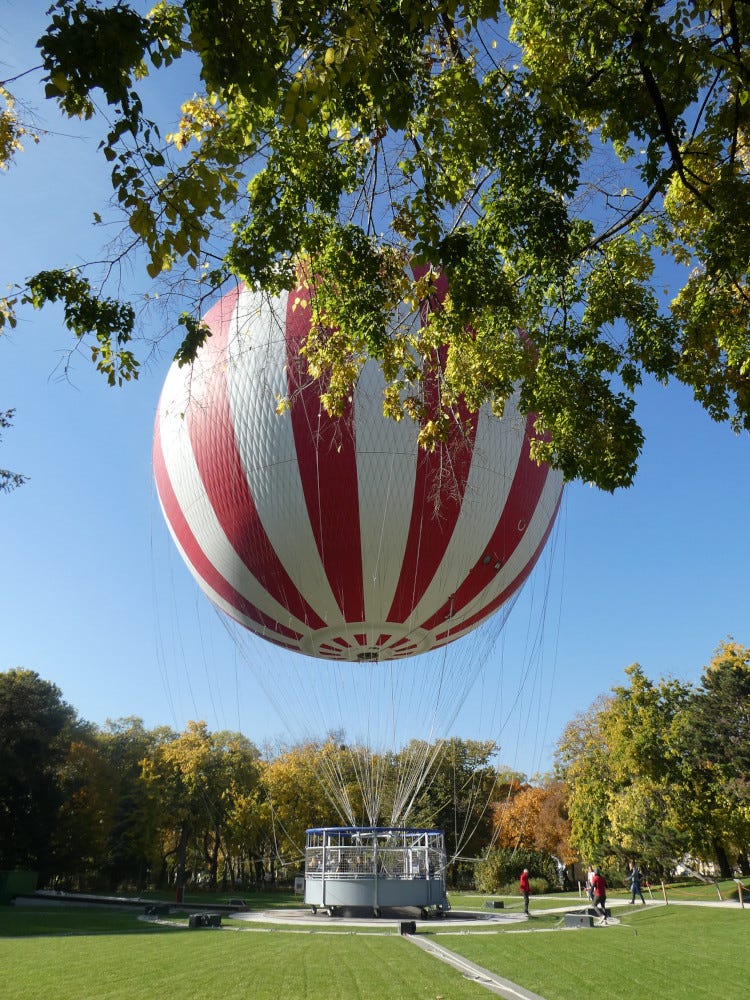
The doughnut-shaped basket can take 40 passengers but we went up with about 20. The pilot spaces you out before taking you up and once you’re up and settled, you can slowly shuffle around so you can see the view from other angles and you get about 15 minutes to take in the views before you start to descend.
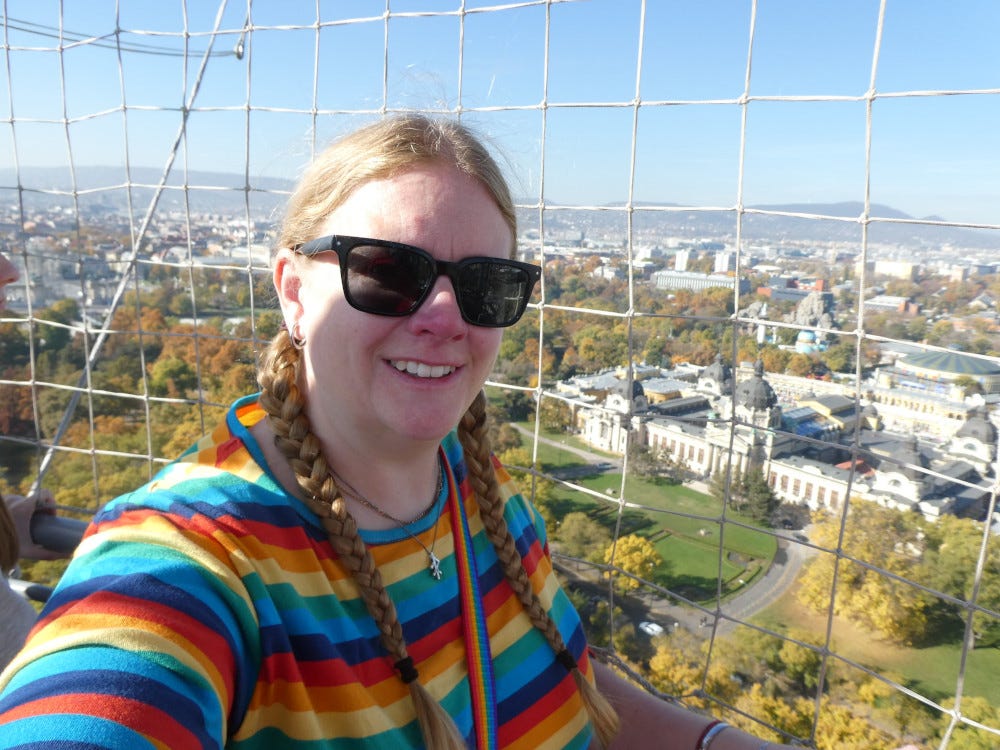
I had a personal recommendation of the House of Music, which my Hungarian colleague hasn’t been to but he says the building is very interesting. So off I went. It’s a circular glass building which blends in astonishingly well with the trees around it. Half of the building is an auditorium and it’s blocked off from the outside world with drapes the height of the building, so those vertical lines do a lot of the work and the pattern underneath the canopy looks like sunlight through leaves which really adds to the impression you’re part of the forest. It has an outdoor theatre, lecture halls, education rooms and most importantly for the tourists, two cafes. The one downstairs is the busy one because anyone wandering in sees the queue and the cups and joins it but the one upstairs has a terrace so you can sit outside and look at the trees. That was a good recommendation and something I definitely wouldn’t have bothered with on my own.
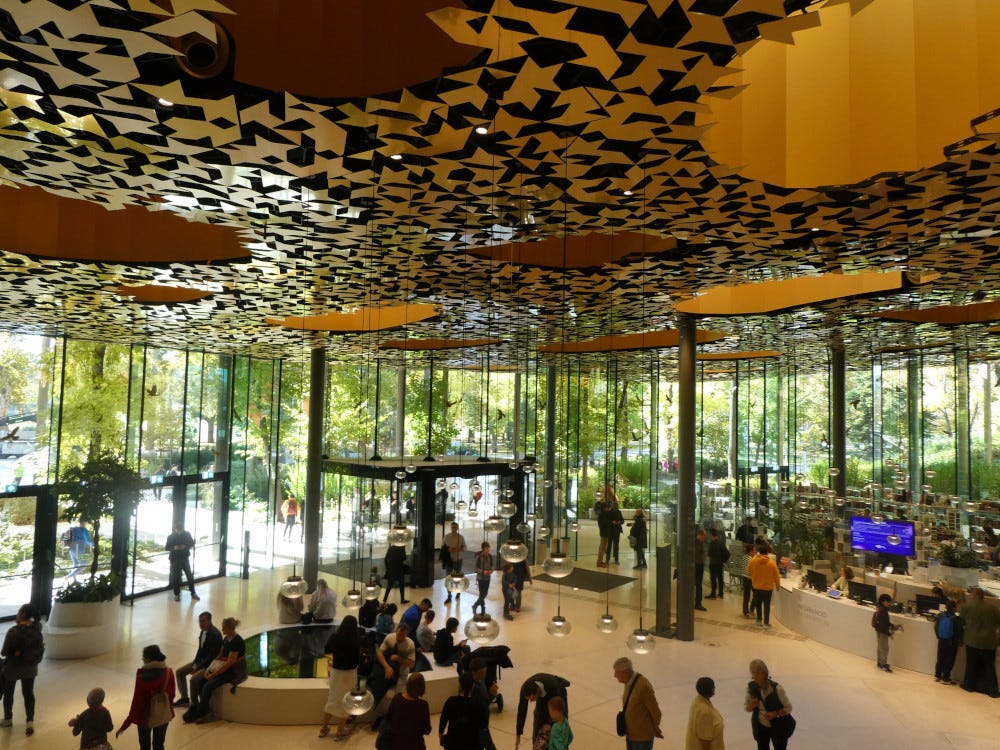
If you’ve got a free half-day, the zoo is right here in the park. My parents like this zoo, my Hungarian colleague described it as “the best zoo” and I think, without having visited it myself, it’s a world-class zoo and definitely worth a visit. I had six thermal baths and an entire city to visit so I didn’t have time. It’s colossal, there’s no point trying to rush through it all in half an hour.
Thermal baths? Like that massive yellow palace in front of the zoo? Ah, now we’re getting to the main reason I came to Budapest in the first place. Here’s Széchenyi Baths! This is the big tourist bath, the one you’ll see all the photos and videos from. It’s the largest medicinal bath in Europe… and you can tell. I like Széchenyi but I didn’t love it.
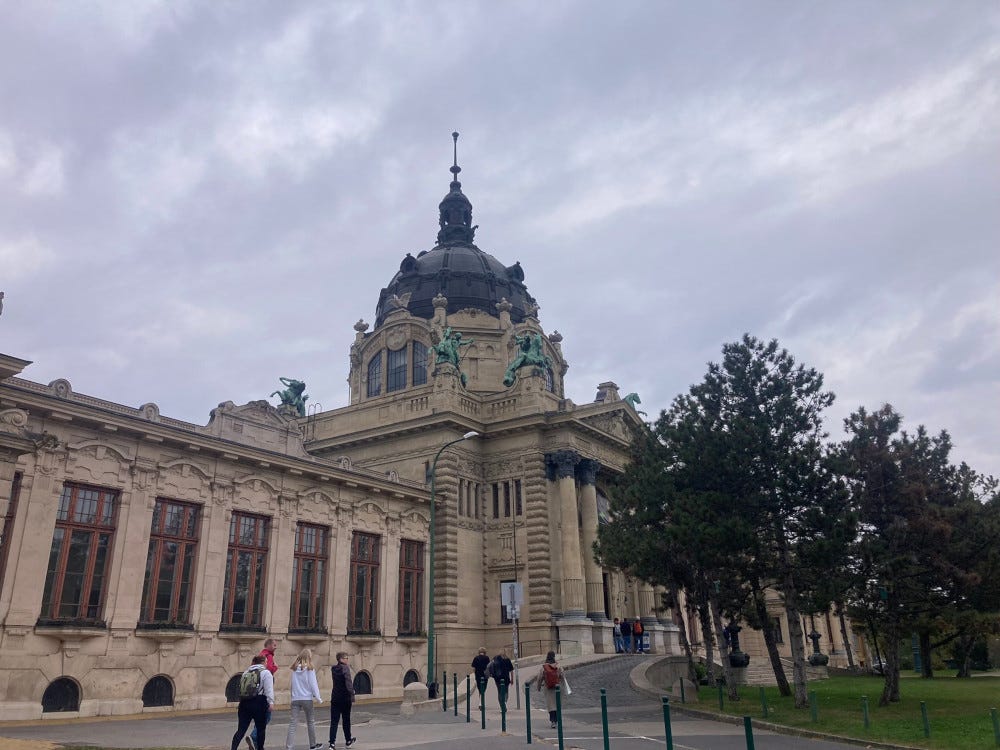
In my haste to book a skip-the-line morning ticket, I didn’t realise I’d booked a private cabin instead of a locker, so that was a fun introduction to Budapest baths, having my own private changing cubicle where I could leave my stuff. It’s the done thing to take a towel with you, even though I really didn’t want to get my towel wet until it was time to dry ready to leave, so I put it in my drybag, which meant I could also carry my sunglasses for the outside bit, my swimming hat for the actual swimming pool and my GoPro, because I wanted to take photos but hadn’t quite figured out where or even if I could use it. The outside pools were great – there’s a rectangular lane pool in the middle, where the lifeguards are mostly watching out for anyone trying to get in without a hat, and then there’s a semi-circular pool at each end. The one where I came out of the changing rooms is the adventure pool, which is bright blue and has various bubble benches, massage jets and a whirlpool. The one at the other end is the thermal pool, which is slightly more green-tinted and very slightly murkier thanks to the minerals, and it’s a good couple of degrees warmer. My guidebook mentioned about six times that people play chess in the water, which I’d never seen mentioned anywhere else so when I saw it for real, I almost started fangirling at it – I’ve heard of this! I didn’t expect to see this! It’s actually here! It’s actually real!
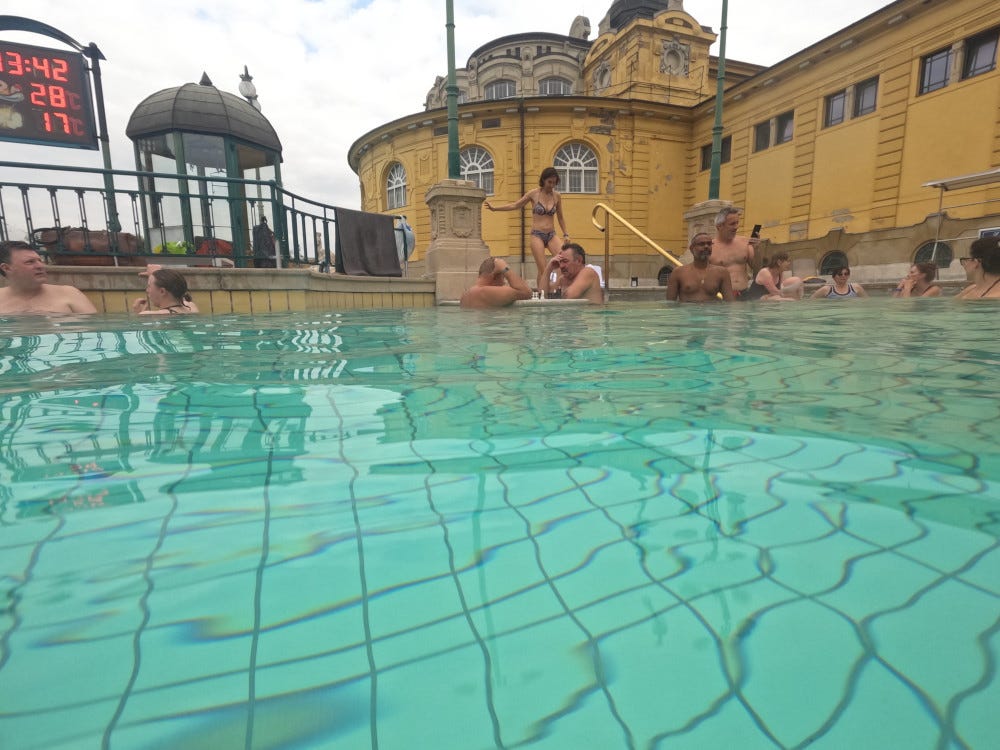
It also has lots of indoor pools, all a lot smaller, of various shapes, sizes and temperatures, plus there’s the hospital pool which you can only use with a prescription or referral but which is surprisingly easy to accidentally walk into. The indoor pools felt a lot more clinical than the outdoor ones, which is partly due to the white tiles and slightly aged feeling of the building and partly due to it being a lot quieter in there. This definitely didn’t have either the party feeling of the outdoor pools or the relaxing luxurious spa feeling I might have expected from somewhere like this. The centre pool was closed so there was no way of getting from the pools on one side to the pools on the other – well, maybe if you go back through the changing rooms – so you have to walk around outside. There are also saunas lurking underneath somewhere.
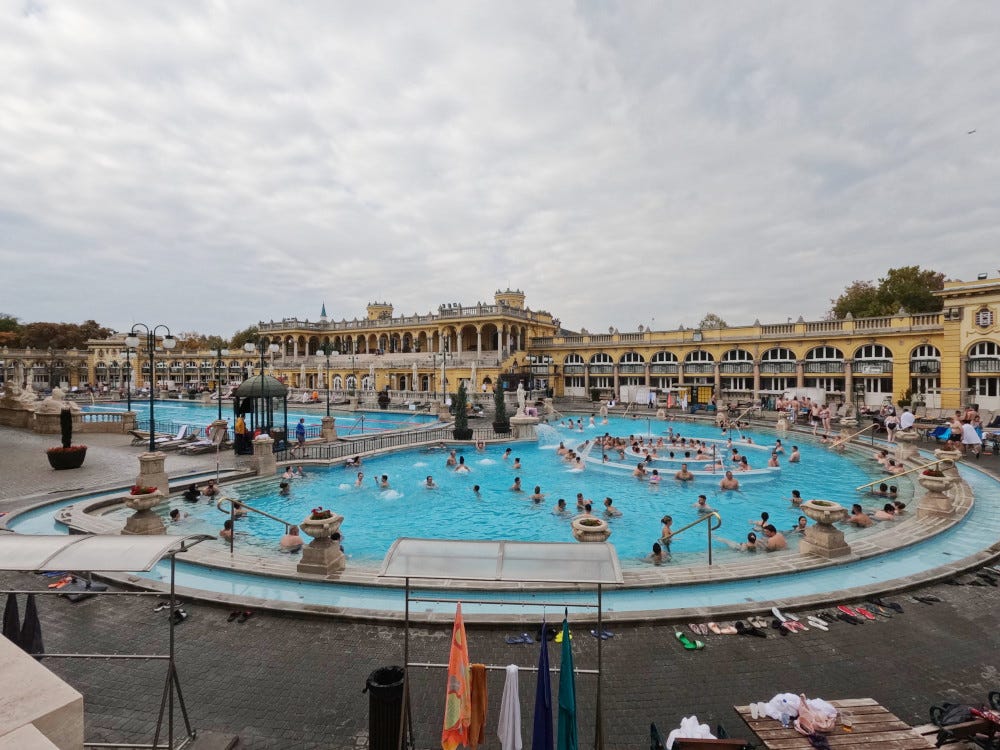
If you’re after some proper luxury and peace, there’s a private spa upstairs for an extra fee, which I gather has treatment rooms and hammocks and a bar and there’s also a beer spa. I didn’t do any of that because the main public baths already has enough pools and enough hot water for anyone. But it’s a spectacular place, a purpose-built bright yellow Neo-Baroque palace and even if you have no interest in hot water, you should come and see this amazing place.
That’s still not everything in the park – I’ve failed to mention the Capital Circus of Budapest, which is a permanent stone circus ring which does circus performances (albeit possibly with animals, which seems odd to still be doing in 2024) all year round, and the Museum of Ethnography, and I haven’t even mentioned just wandering around the park, which is 302 acres of fields, trees, greenery, streams and peace away from the city. You don’t even have to walk all the way back to Heroes Square to get back on the metro, you can jump back on at Széchenyi Baths and in less than ten minutes, you’re back in the city centre.
